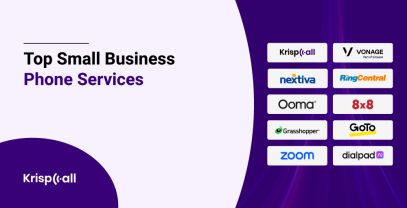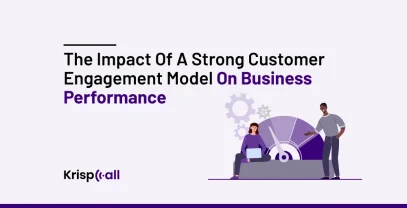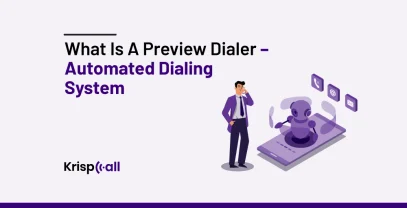Having trouble 😵💫 deciding which communication channels will help you solve your communication problems for your business?
Choosing the right communication channels can be frustrating and challenging. Inefficient business communication channels can lead to missed opportunities, misunderstandings, and productivity losses.
Communication channels are crucial for internal team communication and external communication with customers and clients.
In this blog, you’ll get a comprehensive overview of business communication channels, with their types, and offer real-life examples to help you choose the right one.
✨ Key Highlights
- Written, Oral, Modern, Visual, and Social Media are the key communication channels.
- Communication channels help enhance internal and external communication in a business organization.
- Video conferencing, text messages, Live Chat, and Emails are some examples of communication.
What is a Business Communication Channel?
A business communication channel is a platform for exchanging information and data between people within the workplace and outside the organization. There are different types of information, such as text, verbal, infographic images, and videos; also, they are in hard copy and digital formats.
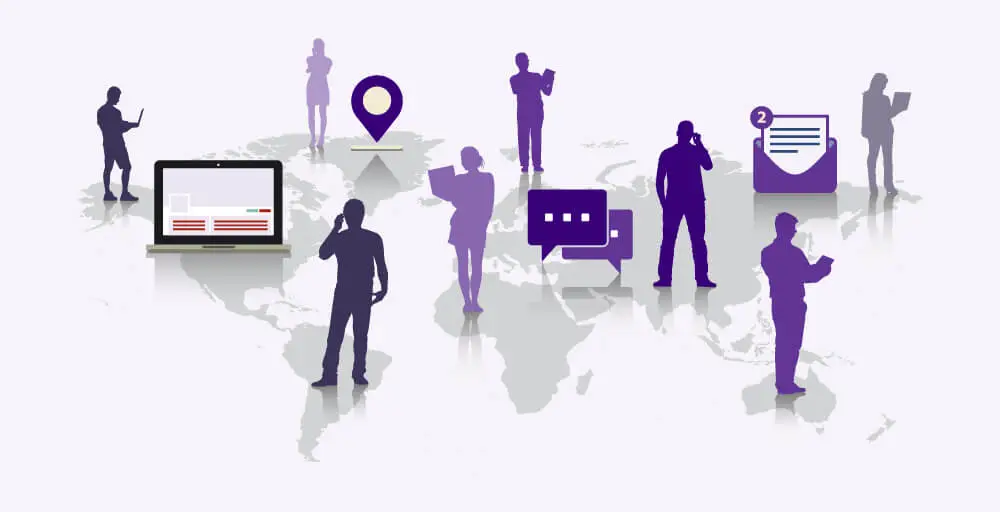
Business requires effective communication as it helps to manage interaction between agents, agents to customers to reach organizational goals. It improves organizational practices and eliminates the chances of errors in the workflows.
Communication channels in business are important as they help in communication strategies, such as managerial communication and technical communication.
What are the benefits of having a communication channel for business?
Communication channels in the business help a lot to ease the workflow, maintain understanding, and share information including:
- Knowledge Sharing: Team members can exchange information and expertise more easily when a communication channel is established. This results in increased problem-solving, innovation, and employee knowledge.
- Built Trust: Communication channels enable building strong personal connections and fostering immediate feedback, which can help build trust among team members.
- Enhance Customer Service: Communication channels can help businesses provide better customer service by enabling them to deliver communication in an instant or timely manner, ensuring each member of the team receives the same information, and increasing productivity.
- Customer Acquisition & Retention: Communication channels can also help businesses acquire and retain customers by allowing them to ask and answer customers’ questions and share information about their products and services.
- Organize Process: Communication channels can help businesses organize their processes by allowing them to match the channel to the message and avoid misunderstandings, delays, or information overload.
What are the different types of Communication Channels for business?
There are different types of communication channels for business.
1. Written
Written communication is defined as emails, texts, letters, and more. Our personal lives are dominated by text messages, but SMS for business can be equally useful, based on your role.
It just makes sense to send a text message in certain situations if you’re quicker to respond to business messages. People nowadays prefer receiving SMS notifications about upcoming appointments rather than receiving phone calls.
2. Oral
The oral channel of communication is the fastest but the least formal. In unplanned meetings and brainstorming sessions, this type of verbal communication is commonly used.
As oral communication can be hard to document, it is often used in conjunction with other forms of communication. Oral communication can take many forms:
- Telephone calls
- Video conferencing
- In-person meetings
3. Visual
A visual communication channel can be formal or informal. The use of visuals can help convey information quickly and effectively, making them ideal for presentations, infographics, Videos, Images, and other types of business communication.
4. Social Media
Social media is a popular platform for informal communication. Using social media for sharing pictures or group chats is a great way to connect with others. We often use social media for small talk, brainstorming, and impromptu meetings.
As digital communication is difficult to document, it’s often used in conjunction with other forms of communication, such as email and instant messaging.
Top 6 Communication Tools For Small Businesses in 2024
There are many communication tools available in the market for streamlining smooth communication for small businesses.
So, we have listed out the Top 6Communication Tools For Small Businesses based on the following factors:
- Features
- Pricing
- Scalability
- Reliability
- User reviews
Let’s have a brief overview of them. 👇
1. KrispCall
KrispCall is the perfect software solution for businesses seeking the best telephony communication channel. VoIP calls, texts, emails, and other features in one option without having to download all the different software.
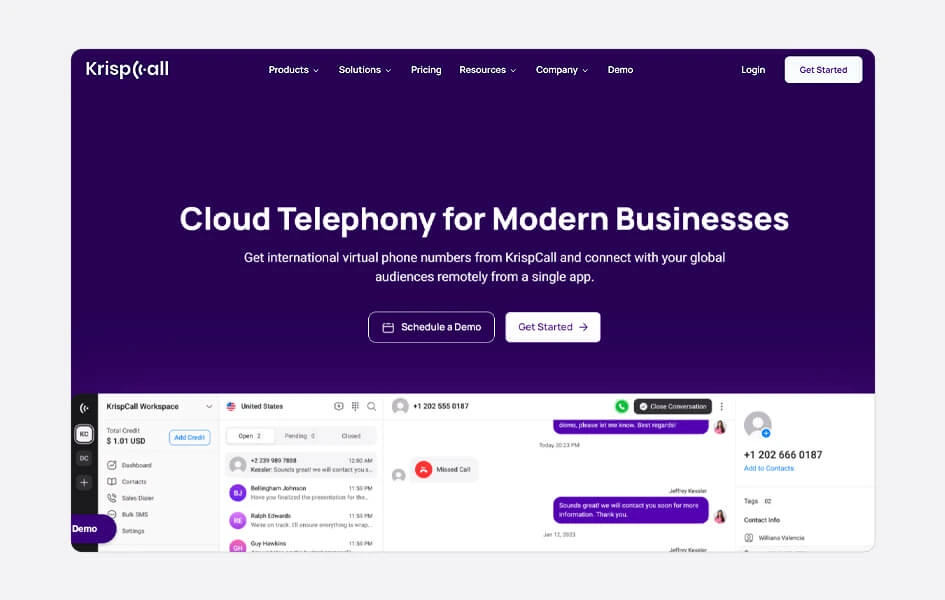
You get all the cloud telephony features along with virtual phone numbers and contact center software that your business telecommunication needs. With KrispCall, no matter what channel of interaction you use, you get a consistent, unified experience regardless of device.
Besides offering its services in more than 100 countries, it also offers affordable pricing plans. Its Unified Callbox feature sets KrispCall apart from the rest of the competition. All calls, SMS, and advanced monitoring features are handled in one place, making it an ideal one-stop solution.
Features
- Unified Callbox
- Voicemail Transcription
- Call Forwarding
- Caller ID
- Number Porting
- Simultaneous Call Handling
- Call Monitoring
- Custom Greetings
- Intelligent Call Routing
- Shared Number
- Global Calling
- Call Monitoring and Recording
Pricing
| Essential | $15/user/month |
| Standard | $40/user/month |
| Enterprise | Custom Quote |
2. Kommo
Kommo is an effective communication tool that synchronizes chats across platforms. With its advanced features, you can leverage productivity and efficiency in your business through individual lead discussions as well as team messaging.

You do not need to open multiple apps to get in touch with potential clients and leads. Kommo allows you to access all their chats from different social media platforms in one place, making communication easy and quick. Kommo also includes a built-in messenger, which facilitates easy communication and collaboration.
Features
- CRM Pipeline
- Chat Inbox
- Sales bot
- Multichannel Communication
Pricing
| Base | $15 USD per user/month |
| Advanced | $25 USD per user/month |
| Enterprise | $45 USD per user/month |
3. ContactMonkey
ContactMonkey is an internal communications management platform that lets businesses create, send, and track email and SMS for employee communications from Gmail or Outlook.
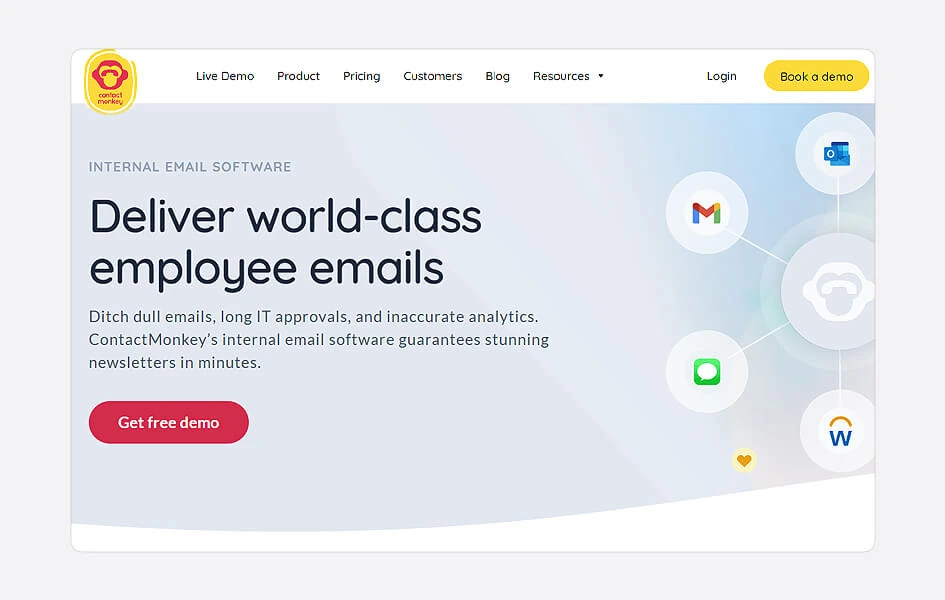
With it, you’ll be able to keep an eye on how many emails are opened and which messages are read by your employees. With its advanced analytics, you can find out how individuals or campaigns are performing. You can identify your most engaged employees by tracking links clicked, emails opened, devices, and feedback.
Features
- Email Tracking and Analytics
- List Management
- SMS and Event Management
- Email Customization
Pricing
Contact sales Team
4. Slenke
Slenke is a virtual workspace and communication platform for managing businesses remotely. With Slenke, you can manage time and tasks while communicating with colleagues.
Chats can be organized into teams, groups, and message boards for participants. Your files and messages are encrypted for security to ensure the highest level of security.
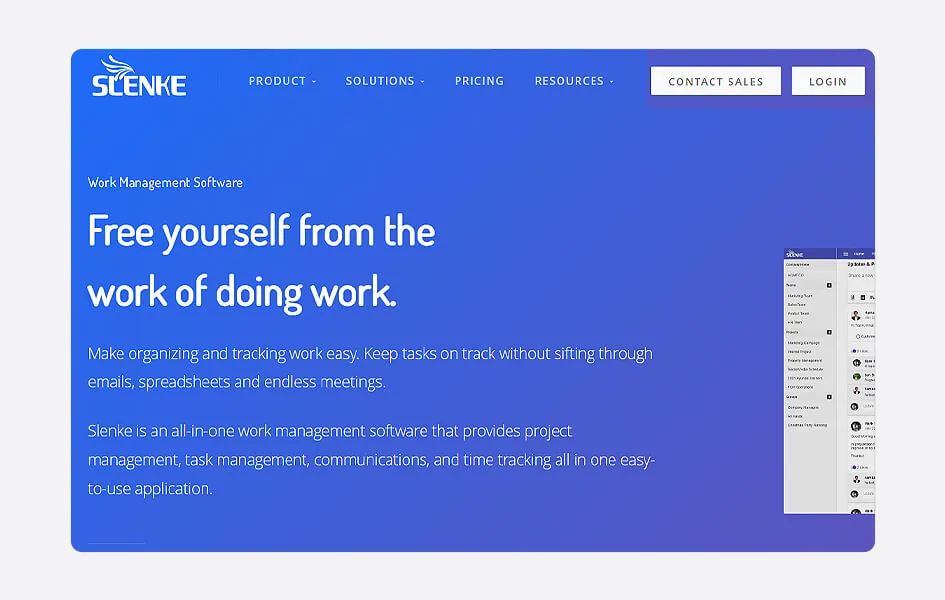
Although it has great features, it lacks screen-sharing and video-conferencing capabilities. If you want a unified experience, you’ll need a separate video conferencing tool, and Slenke is integrated with it.
Features
- Team Messaging
- Kanban Boards
- Gantt Charts
- Time Tracking
Pricing
| Premium | $18 per user per month |
| Enterprise | Custom |
5. RingCentral
RingCentral is a VoIP service provider you can opt for your communication channel tool for your business. From a single app, you can access a phone system, video meetings, SMS, and messaging tools.
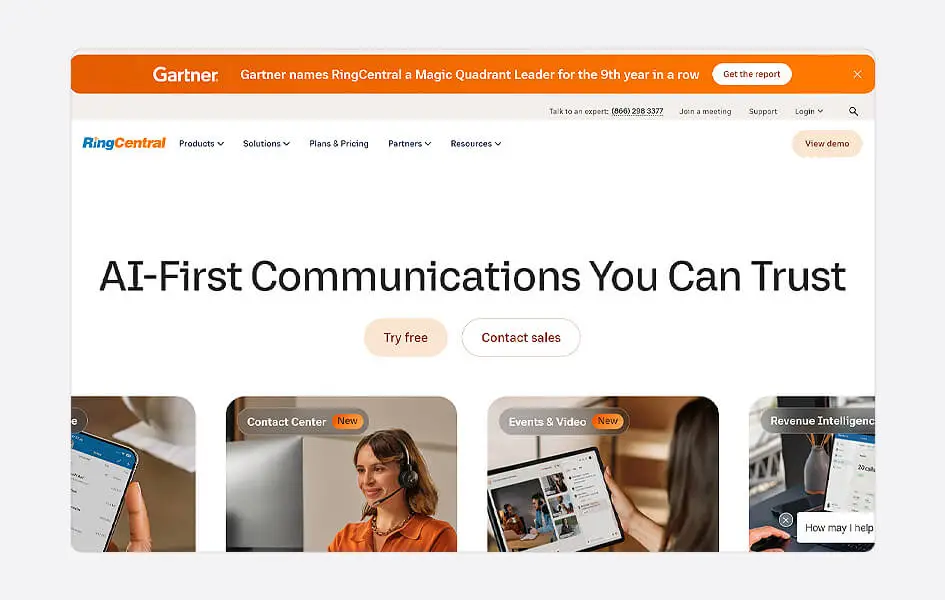
Small business owners have expressed satisfaction with the advantages of RingCentral’s services; users cited reliability, user-friendliness, and seamless day-to-day operations.
Features
- Team Messaging
- Business Phone System
- Enhanced Business SMS
- Video Meetings
Pricing
| Core | $30.00 per user/month |
| Advanced | $35.00 per user/month |
| Ultra | $45.00 per user/month |
6. Podium
Podium is a solution for small businesses to improve customer service and communication. Your support team can easily interact with customers through multiple communication channels using Podium’s suite of tools.

The comprehensive features, ease of use, and focus on reputation management and customer service make Podium a great choice for small businesses
Features
- Phones & Calling
- SMS Messaging
- Website Contact Forms
- Unified Inbox
Pricing
| Essentials | $249 per month |
| Standard | $409 per month |
| Professional | $599 per month |
6 Examples of Communication Channels for Your Business
There are different channels of communication types you can implement for your business. Some of the most common and leading communication channels are given below.
1. Face to Face Communication
When you want a more personal touch than you can get from emails or text messages, video calls are the perfect solution. You can also use this direct channel call for training sessions and team meetings.
There’s nothing like face-to-face communication for reliable exchange of information, but you need to be more presentable on video. However, nonverbal communication, such as body language and facial expressions, is still important.
The Best Time To Use It
When you need to discuss complicated business decisions or important issues with a remote team, video conferencing is ideal.
Some industries require video conferencing for external purposes, especially where clients expect face-to-face meetings. Companies and organizations in finance, legal, and healthcare (telehealth!) tend to need to meet virtually beyond written correspondence and voice calls.
2. Text Message
Many of us use text messages in personal communication. However, SMS can be useful for business, depending on your role and industry.
A text message might just make more sense in certain situations because some people are more responsive to business messages than phone calls.
The best time to use it
A text message allows you to send a direct and simple message quickly and unobtrusively.
It’s not unusual for some sales reps to prefer text messages because their prospects prefer them, and they can also respond faster.
3. Instant Messaging
Like text messaging, instant messaging lets you communicate quickly and directly with your clients or teams. It is in this channel that most information flows freely.
Generally, this channel of communication is more internal than external, but it is important to note that some sales representatives have messaging threads with their prospects or clients as well.
The Best Time To Use It
Whenever you require quick, informal answers, messaging is your best bet. There is no pressure to respond right away because people are generally not expecting immediate responses.
This is also a great asynchronous communication channel for the business team since everyone doesn’t have to meet together.
4. Phone Calls
A phone call is an effective method for communicating with customers in real time. The phone isn’t always a great way to get a response; it’s just the quickest way to respond, and for quick, direct, and effective communication, it’s hard to beat.
The Best Time To Use It
The telephone is one of the most widely used formal communication channels, especially when talking to teammates or clients.
It would have to be verbal only (for visuals, use video conferencing, of course).
If you have frequent customer conversations on the phone, you might want to consider call center software that can help your team communicate more effectively.
5. Live chat
Live chat works on your website, and most of your clients (or potential clients) prefer to contact you via your website.
When you visit a company’s website, you often see a pop-up window asking for your assistance.
The Best Time To Use It
You may want to consider using live chat on your website if you receive enough inquiries there to justify it.
You can provide faster service with live chat because an employee of your support team can generally handle multiple live chats at the same time.
6. Emails
Email is still the most popular and effective means of formal communication in the written form. Despite the fact that email overload can be a problem, it does not look to disappear anytime soon. When used properly, it’s a great way to communicate, and it keeps track of everything you do.
The Best Time To Use It
Email is the best communication channel for keeping track of a conversation or the files shared in that conversation.
Ironically, email’s main disadvantage is its own popularity. Every day, we get bombarded with emails because they’re overused and people just use it, even when there’s a better way to communicate.
How do you choose the best Communication Channels for your Business?
How you communicate your message is essential for effective communication at work. You can take steps to help you decide how to choose the best communication channels for your business.
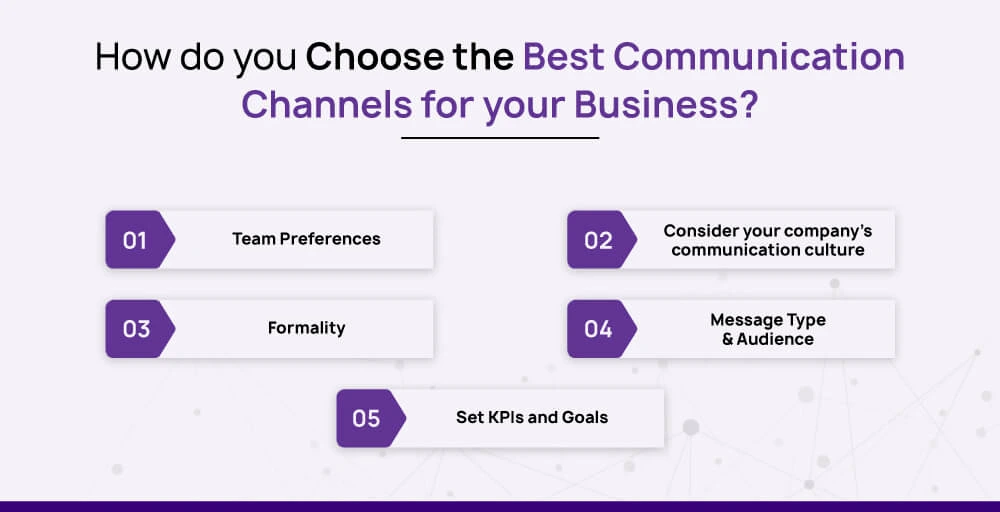
1. Team Preferences
When you choose channels that your team is most comfortable with, you will be able to leverage their strengths and communicate effectively. Consider whether your internal or external communication needs to be strengthened.
For smaller businesses, budget and resources are also crucial since too many channels can lead to miscommunications, unanswered messages, and inconsistent service quality.
2. Consider your company’s communication culture
A study by Slack on the Future of Work Study found that teamwork, tools, and trust are crucial components of employee productivity. Furthermore, 80% of employees want to know how their company makes decisions.
When your team prefers face-to-face communication, delivering bad news face-to-face may be necessary. If you value work-life balance, you shouldn’t send a direct message after midnight.
3. Formality
Another factor to consider is formality since different channels have different degrees of formality. A formal channel might be an email or a phone call, while an informal channel might be an instant message or social media.
Different channels can work better for different types of businesses, so business requirements are also important. The best method of customer service is via the phone, while live chat is perfect for e-commerce companies.
4. Message Type & Audience
If you need to communicate information, start by asking yourself a series of questions.
- What is the formality of your message?
- Is this information to be backed up by references?
- Do you need this information urgently?
- What information are you communicating that is sensitive or confidential?
- Are you communicating with your team or with the entire company?
- Does this communication require a response (that is, is it two-way or one-way)?
5. Set KPIs and Goals
Set KPIs and goals for monitoring your company’s new communication channels once you’ve decided on them. Watch how your customer service contact changes if you receive unfavorable feedback often. Monitor your team’s communication and other performance indicators that are influenced by it.
What are the challenges that may arise while using the wrong communication channels?
You might not realize how varied and complex the communication challenges at work are. For each medium, there are different types and levels of involvement required. Here are some of the challenges you can face while using the communication channels.
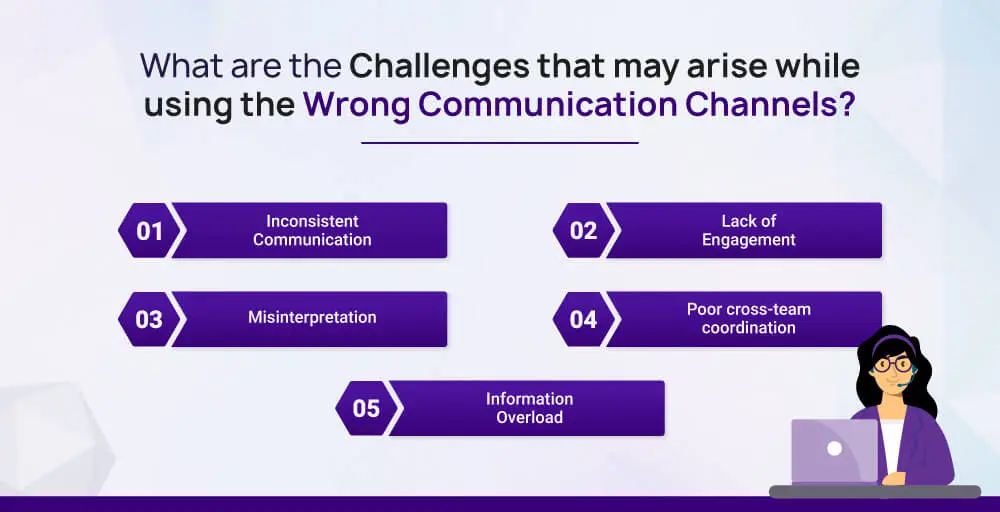
Inconsistent Communication
Many employees face a communication challenge today because communication channels are inconsistent, which means switching between tools at random.
Rather than investing valuable time in their tasks, employees waste time searching for information across all available channels. Inconsistency in internal communication can lead to a severe drop in workforce productivity
Lack Of Engagement
The engagement of employees is a critical component of effective workplace communication. You cannot encourage effective communication in an office if your colleagues do not take the time to listen.
Choosing the right motivational messages for your employees is crucial. In fact, it can be very challenging to communicate, but one that can completely transform your business.
Misinterpretation
Cultural and linguistic barriers can lead to significant misinterpretations and miscommunications. Animosity and conflict can result from misinterpretations of words and gestures.
A lack of collaboration caused by poor relationships and mistranslation among co-workers can cost businesses a lot. Therefore, fostering cross-cultural communication is essential.
Poor Cross-team Coordination
Even though there may be lots of teams in an organization, each with a clear role, you look at your business as a whole when you assess its performance. As a result, departments in an organization must remain connected, regardless of their independence.
Whenever parties do not communicate key elements of their shared tasks, poor cross-team coordination occurs. Businesses should manage interdepartmental coordination carefully, as it can prevent them from accomplishing their goals.
Information overload
You can encourage employee engagement by keeping them informed of important business decisions. You should not overwhelm them with unnecessary information, flood their inboxes, and interfere with the flow of their work and their focus.
Meetings and e-mails that are unnecessary can be distracting, which hinders productivity. Consider carefully if all topics covered in a meeting or email are relevant to the entire team before calling a meeting.
Conclusion
Communication is the key to the success of every business and its teams, and to communicate efficiently, you’ll need the best communication channels. You should have knowledge about different communication channels, how to use them, and in what situation you should use.
Choosing and using the right communication channels will help you to streamline workflows and exchange information smoothly internally and externally. You should research and recognize the strengths and weaknesses of various communication platforms before you implement them.
If you’re looking for a reliable telecommunication channel for your workspace, we recommend trying KrispCall. KrispCall offers a range of features such as text, calls, and advanced telephony features that help you communicate with your agents and customers gracefully.
FAQ
How many channels of communication are there?
There are five different types of communication channels. They are:
- Written
- Oral
- Modern
- Visual
- Social Media
What Are The Different Types Of Communication Channels By Formality?
There are three different types of communication channels by formality. they are:
- Formal communication channel
- Informal communication channel
- Unofficial communication channel
How to select the right communication channels for your business?
Here are the steps to select the right communication channels for your business:
- Determine Your Purpose for the Communication.
- Formality
- Consider Your Audience.
- Choose A Clear, Efficient Communication Method Aligned to the Message and Your Audience.
- Set KPIs and Goals
What are the key metrics to track for communication channels?
The key metrics to track for communication channels are:
- Rates of employee engagement
- Intranet Read-Receipts or Open Rates
- Feedback from employees
- Rates of employee turnover
- Rates of mobile usage



